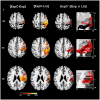Lesions to primary sensory and posterior parietal cortices impair recovery from hand paresis after stroke
- PMID: 22363604
- PMCID: PMC3282712
- DOI: 10.1371/journal.pone.0031275
Lesions to primary sensory and posterior parietal cortices impair recovery from hand paresis after stroke
Abstract
Background: Neuroanatomical determinants of motor skill recovery after stroke are still poorly understood. Although lesion load onto the corticospinal tract is known to affect recovery, less is known about the effect of lesions to cortical sensorimotor areas. Here, we test the hypothesis that lesions of somatosensory cortices interfere with the capacity to recover motor skills after stroke.
Methods: Standardized tests of motor skill and somatosensory functions were acquired longitudinally over nine months in 29 patients with stroke to the pre- and postcentral gyrus, including adjacent areas of the frontal, parietal and insular cortices. We derived the recovery trajectories of each patient for five motor subtest using least-squares curve fitting and objective model selection procedures for linear and exponential models. Patients were classified into subgroups based on their motor recovery models. Lesions were mapped onto diffusion weighted imaging scans and normalized into stereotaxic space using cost-function masking. To identify critical neuranatomical regions, voxel-wise subtractions were calculated between subgroup lesion maps. A probabilistic cytoarchitectonic atlas was used to quantify of lesion extent and location.
Results: Twenty-three patients with moderate to severe initial deficits showed exponential recovery trajectories for motor subtests that relied on precise distal movements. Those that retained a chronic motor deficit had lesions that extended to the center of the somatosensory cortex (area 2) and the intraparietal sulcus (areas hIP1, hIP2). Impaired recovery outcome correlated with lesion extent on this areas and somatosensory performance. The rate of recovery, however, depended on the lesion load onto the primary motor cortex (areas 4a, 4p).
Conclusions: Our findings support a critical role of uni-and multimodal somatosensory cortices in motor skill recovery. Whereas lesions to these areas influence recovery outcome, lesions to the primary motor cortex affect recovery dynamics. This points to a possible dissociation of neural substrates for different aspects of post-stroke recovery.
Conflict of interest statement
Figures




Similar articles
-
Cerebellar hemispheric activation ipsilateral to the paretic hand correlates with functional recovery after stroke.Brain. 2002 Jul;125(Pt 7):1544-57. doi: 10.1093/brain/awf148. Brain. 2002. PMID: 12077004
-
Enhanced Effective Connectivity Between Primary Motor Cortex and Intraparietal Sulcus in Well-Recovered Stroke Patients.Stroke. 2016 Feb;47(2):482-9. doi: 10.1161/STROKEAHA.115.011641. Epub 2016 Jan 7. Stroke. 2016. PMID: 26742802
-
Parietofrontal network upregulation after motor stroke.Neuroimage Clin. 2018 Mar 7;18:720-729. doi: 10.1016/j.nicl.2018.03.006. eCollection 2018. Neuroimage Clin. 2018. PMID: 29876261 Free PMC article.
-
Integrated technology for evaluation of brain function and neural plasticity.Phys Med Rehabil Clin N Am. 2004 Feb;15(1):263-306. doi: 10.1016/s1047-9651(03)00124-4. Phys Med Rehabil Clin N Am. 2004. PMID: 15029909 Review.
-
Somatosensory and motor disturbances in patients with parietal lobe lesions.Adv Neurol. 2003;93:179-93. Adv Neurol. 2003. PMID: 12894408 Review.
Cited by
-
Isolated hand paresis: a case series.Cerebrovasc Dis Extra. 2013 Apr 17;3(1):65-73. doi: 10.1159/000350708. Print 2013 Jan. Cerebrovasc Dis Extra. 2013. PMID: 23687503 Free PMC article.
-
Robotic-based ACTive somatoSENSory (Act.Sens) retraining on upper limb functions with chronic stroke survivors: study protocol for a pilot randomised controlled trial.Pilot Feasibility Stud. 2021 Nov 15;7(1):207. doi: 10.1186/s40814-021-00948-3. Pilot Feasibility Stud. 2021. PMID: 34782024 Free PMC article.
-
Influencing factors of corticomuscular coherence in stroke patients.Front Hum Neurosci. 2024 Mar 18;18:1354332. doi: 10.3389/fnhum.2024.1354332. eCollection 2024. Front Hum Neurosci. 2024. PMID: 38562230 Free PMC article. Review.
-
Fine Motor Skill Decline After Brain Radiation Therapy-A Multivariate Normal Tissue Complication Probability Study of a Prospective Trial.Int J Radiat Oncol Biol Phys. 2023 Nov 1;117(3):581-593. doi: 10.1016/j.ijrobp.2023.04.033. Epub 2023 May 6. Int J Radiat Oncol Biol Phys. 2023. PMID: 37150258 Free PMC article.
-
The prevalence and magnitude of impaired cutaneous sensation across the hand in the chronic period post-stroke.PLoS One. 2014 Aug 14;9(8):e104153. doi: 10.1371/journal.pone.0104153. eCollection 2014. PLoS One. 2014. PMID: 25121607 Free PMC article.
References
-
- Amunts K, Zilles K. Advances in cytoarchitectonic mapping of the human cerebral cortex. Neuroimaging Clin N Am. 2001;11:151–169, vii. - PubMed
-
- Eickhoff SB, Stephan KE, Mohlberg H, Grefkes C, Fink GR, et al. A new SPM toolbox for combining probabilistic cytoarchitectonic maps and functional imaging data. Neuroimage. 2005;25:1325–1335. - PubMed
-
- Papageorgiou E, Ticini LF, Hardiess G, Schaeffel F, Wiethoelter H, et al. The pupillary light reflex pathway: cytoarchitectonic probabilistic maps in hemianopic patients. Neurology. 2008;70:956–963. - PubMed

